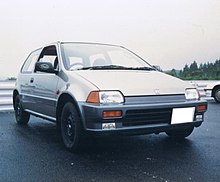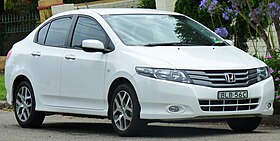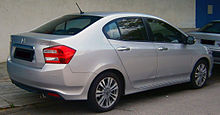Honda city 2016
The first generation Honda City was asubcompact car and is now a compact carsince the fifth generation, and is manufactured by the Japanese manufacturerHonda from 1981. Originally made for the Japanese, European and Australasian markets, the City was retired in 1994 after the second generation.
The nameplate was revived in 1996 for use on a series of compact four-door sedans aimed primarily at developing markets, first mainly sold in Asia outside Japan but later also in Latin America and Australia. From 2002 to 2008, the City was also sold as the Honda Fit Aria in Japan. It is a compact sedan built on Honda's Global Small Car platform, which it shares with the Fit/Jazz (a five-doorhatchback), the Airwave/Partner (awagon/panel van version of the Fit Aria/City), the Mobilio, and the Mobilio Spike—all of which share the location of the fuel tank under the front seats rather than rear seats. By mid-2009, cumulative sales of the City has exceeded 1.2 million units in 45 countries around the world since the nameplate was revived in 1996.[1]
In 2011, the City is also sold as the Honda Ballade in South Africa.
First generation (1981–1986)
Main article: Honda City (AA)
The first Honda City (AA for sedans, VF for vans and FA for the wider Turbo II and Cabriolets) was introduced in November 1981 with the innovative "Tallboy" design; of unusual height it enabled four adults to fit comfortably in the very short City (under 3.4 m or 11.2 ft).[2] Produced as a 3-door hatchback in a variety of trim levels, the City was also available together with theMotocompo, a special 50cc 'foldaway' scooter designed to fit in the City's small luggage area. At the time of its introduction, it was Honda's smallest car, while not being in compliance with Japanese Government keiregulations. It was longer than the Honda N360 by 383 millimetres (15.1 in), but shorter than the Honda Civic first generation by 171 millimetres (6.7 in).
The Honda City Turbo was introduced in September 1982. It was powered by aturbocharged version of the 1231 cc Honda ER engine. A Pininfarina designed drop-top Cabriolet utilized the wider fenders and bigger bumpers of the Turbo II "Bulldog", but was only normally available with the naturally aspirated 67 PS (49 kW) engine. There was also a Pro-series of van versions with either two or four seats. A high-roof "R Manhattan Roof" version with a 10 cm taller roof also appeared.
Exports of the City were primarily to Europe (where it was renamed Honda Jazz, due toOpel having trademarked the City name), Australia (in two-seater 'van' form, to circumvent Australian import restrictions on passenger vehicles at the time) and New Zealand (where it was locally assembled). Production ended in late 1986 with the introduction of the GA type City.
Second generation (1986–1994)
Honda replaced the original City series AA in November 1986 with this generation (designated GA1), and again with an update in 1989 (GA2). This model was produced until 1994. The Fit name also first appeared as a trim variant of the City. There was no convertible model, with both the convertible and Turbo models of the previous generation continuing on sale for a little while.[3] In most markets aside from Japan, the City's market position was left open until filled by the Honda Logo in 1999.
October 31, 1986 the second City was introduced with the slogan "City of talent." in Japan, and was available at Honda Cliodealerships. The Honda Clio dealership chain was being positioned as Honda's purveyor of luxuriously equipped vehicles like the Honda Legend, the Honda Concerto, and the Honda Accord, and this generation City enabeled Cliolocations to sell economically priced vehicles normally found at Honda Primo.
In this remodel, there are major changes in the appearance of the vehicle Honda called "Crouching form", which consisted of a low and wide design that contributed to lighter vehicle weight (basic grade 680 kg) combined with improvements in driving performance. The styling reflects a corporate decision to enact a shared appearance with the first generation Honda Today kei car, the internationally strong seller, third generationsubcompact Honda Civic, and the third generation compact Honda Accord AeroDeck. This generation shared its exterior dimensions and engine size almost exactly with the first generation Civic. The Honda CR-X was the only three-door hatchback that adopted a fastback, sloping rear hatch, similar to the Honda Verno products during the mid-1980s.
The engine configuration introduced the Honda D series, in the form of the type D12A, a 1.2 L SOHC straight-four 16-valve unit (1986, first as a mechanism for domestic vehicles) only available with a single carburetor, and basic level of equipment. The difference between the "GG" / "EE" / "BB" were just in the level of equipment. Power is 76 PS (56 kW) at 6,500 rpm. A five-speed manual or a four-speed automatic transmission were optional.[3]
In October 1988 the main engine was changed to 1.3 L I4 SOHC type D13C. At this time, in addition to the traditional single carburetor, and introduced Honda's PGM-FI fuel injection. Single carburetor specification, the 1.2 L "BE" the other 1.3 L "CE" / "CG" is set, PGM-FI, spec, "CR-i" / "CZ-i" and consists of two trim packages.
The "CE" grade equipment with enhanced savings "CE Fit", PGM-FI specification is "CR-i" based only high-grade "CR-i Limited" was introduced, the late "CZ-i" is defined as the minor trim package. The word "Fit" appears as a trim package on the base grade "CE".
At the end of this generation, by grade consolidation, "Fit" is used for all single carburetor vehicles. The trim package "Fit" later became the model name of the successor of the Honda Logo which replaced this car.
The second generation was discontinued in 1993. The name "City" was retired at the end of this series' conclusion of production. The replacement vehicles introduced in 1996 on the GA base were renamed "Honda Logo" (three-door hatchback, GA3/5 series), and theHonda Capa with five-door hatchback bodywork.
Third generation (1996–2002)
Fourth generation (2002–2008)
The fourth generation City made its world debut at the Thailand International Motor Expo in November 2002. It was now offered as a four-wheel drive version. It was imported from Thailand and launched as Fit Aria in Japan domestic market[5] from December 20, 2002. The word "aria" is a type of expressive melody, usually heard in opera. Honda chose the word, continuing its musical naming tradition used with the Honda Prelude, theHonda Accord, the Honda Ballade, the Honda Quintet, and the Honda Concerto. In the People's Republic of China, the model was named Fit Saloon and was sold from September 2003 to December 2008.
The Honda City was initially launched with a twin-spark, lean burn ‘i-DSI’ engine producing 88ps that was primarily designed to provide outstanding fuel economy. The VTEC version of the Honda city is launched later. The VTECtrim of the Honda city is offered with 15-inch alloy wheels compared to the 14-inch offered in the i-DSI and the rear brakes are solid discs on the VTEC variant instead of drums in the i-DSI. Also, the VTEC model uses a 7-speed Multimatic CVT automatic transmission.

Speedometer dials on a Honda CityVTEC model.
In September 2005, a facelifted version of the City was launched in Thailand, in October 2005 in Malaysia, and in November 2005 inIndonesia. In Thailand it is known as the City ZX. The most significant changes are a new exterior (new front grille, new headlamps, new fog lights, new taillights and bumpers). The front end has been extended forward by 65 mm (2.6 in) while the rear has been extended by 15 mm (0.6 in). The side mirror is electronically foldable. Both the i-DSI andVTEC trim levels have 15-inch alloy wheels as standard equipment. Interior changes are minor but it does include an armrest for the driver and additional map lights. The interior colour tone of the VTEC variant is now black.
The L-series engine remained but the intake manifold has been repositioned, resulting in a 6 °C drop in the intake air temperature,[6] thesuspension has been upgraded as well.
Honda City in India, Thailand, Indonesia, Philippines, Pakistan, Singapore and Malaysia uses the CVT gearbox for both i-DSI and VTECvariants. The CVT gearbox simulates a 7-Speed automatic transmission with Tiptronicstyle override using paddle shift buttons on the steering wheel itself.
This model also saw limited availability in certain right-handed traffic markets outside Asia such as Egypt.
The fourth generation was resurrected in China as the Everus S1, a new budget car brand for previous Honda models.[7] It stopped production in 2014 selling around 4,500 units.
- Models
City/Fit Aria:
- GD6: 1.3 L L13A i-DSI Inline-four engine2WD (Fit-Aria)
- GD7: 1.3 L L13A i-DSI Inline-four engine4WD (Fit-Aria)
- GD8: 1.5 L L15A i-DSI/VTEC Inline-four engine 2WD (Fit-Aria)
- GD9: 1.5 L L15A i-DSI/VTEC Inline-four engine 4WD (Fit-Aria)
Fifth generation (2008–2013)
The fifth generation Honda City was unveiled in Bangkok, Thailand in September 2008 followed by launches in India, Pakistan, Malaysia,[8] Indonesia, Philippines, Singapore and China (Guangzhou Honda) in the following months. It is manufactured in number of locations including Turkey, Thailand, Pakistan and Brazil.
Starting with this generation, the City was bumped up into a compact car size segment.
Depending on market conditions, the City is available in a range of engine and specification levels. Generally in Asian markets the City comes in three variants – S, V and SV models. In some markets the V and SV is replaced by the E. For South America the range includes the DX, LX, EX, and EXL models.
The range of four-cylinder engines include a 1.3 producing 73 kW (98 hp) at 6,000 rpm,[9] a 1.5 engine putting out 120 PS (88 kW), which both are available in manual and automatic transmissions (Indonesia) and a 1.8-literR18A engine (China markets only).[10]
In South America the range is offered with the i-VTEC 1.5-liter flex-fuel engine that is shared with the Brazilian Honda Fit. The power output is 115 hp with petrol and 116 hp usingethanol. Manual and automatic gearboxes are available.
In the Philippines, the 5th generation City was launched in 2009 available in 2 trims: 1.3 S and 1.5 E. The 1.3 liter is available in 5 speed manual or 5 speed automatic while the E variant is only available in 5 speed automatic with paddle shifters.
The City was briefly offered in selected European countries including Poland with a 1.4-litre i-VTEC engine mated to either a 5-speed manual or a 6-speed i-SHIFT automated manual transmission.
Since it was launched in India in November 2008, the City became the best-selling model of the company in the country, with sales volume even surpassing that of Thailand, previously the best selling market for the City. The Honda City has been the leader in the premium mid-sized sedan segment for a decade, with 35% market share in 2010.[11]
In February 2009, Honda Australia have released the Thai-made City into the Australian market in two 1.5-litre variants (VTi and VTi-L). According to Honda Australia's boss, Yasuhide Mizuno, the City will compete with other light sedans such as the Japanese built Toyota Yaris, the Korean-made Holden Barina and the Nissan Tiida (also Thai).[12]This will be the first City released in Australia since the 1980s. It replaces the formerly smaller-sized Civics.
The City was launched in 2011 in South Africa as the Ballade,[13] to fit below the Civic and above the Jazz (Fit) sold there.[14]
Facelift
In September 2011, Honda Automobile (Thailand) Ltd revealed the revamped Honda City, with new front grille design, new front and rear bumpers, new taillamps design, new alloy wheels, eco driving indicator and dual front airbags to every model.[15] The revised model was launched in India in December 2011 including five variants – Corporate, E, S, V and V (Sunroof)[16] – and increased ground clearance to 165mm (previously 160mm) and also length increased by 20mm.
Honda cars Philippines launched the facelift version of the City in early 2012 it has redesigned front grille,front and rear bumper and new alloy wheels for the 1.5.E variant,Blue Illumination gauge and silver accent aircon switch.In 2013 a new designed alloy wheels for both 1.3. And 1.5. Variants and a color of the City has been replaced habanero red has been replaced with carnelian red for the city.Modulo is available in both variants and in 2013 a mugen version is available for the 1.5.Variant only.
Honda Siel Cars India the Indian subsidiary of Honda Motors has launched the facelifted Honda City 2012 in India. The new Honda City 2012[17] is launched in India in seven variants. All variants are powered by the same 1.5 litre i-VTEC petrol engine which delivers 118PS of power with 146Nm of maximum torque. Also, the company is planning to launch the Honda City diesel variants in the local market, which is expected to be launched by the end of year 2012. Here is the list of Honda City petrol models with their respective features.
Honda Atlas (Pakistan) resumed the production of Honda City on May 1, 2012 after it was halted due to supply chain disruption caused by massive flooding in Thailand. This resumption of production is marked by Honda as it comes with the range of facelifted Honda City under the banner of Honda City Aspire. In October, 2014 Honda Atlas launched the facelifted Honda City, with new features including new taillights, revamped chrome grille, blinkers on side mirrors, rear window brake light, keyless entry system and new bumpers. The interior also received some changes. The speedometer dials were changed from orange to blue optitron.
Production
The Honda City is produced in a number of locations around the world including India, Pakistan, Philippines and Thailand.[18]
In July 2009, the City was for the first time to be built and marketed (in large numbers) outside Asia, with production commenced in Sumaré, Brazil. The car was first available for sale in the Brazilian market, with exports to Mexico and other markets in Latin America from September 2009.[1][19]
Since March 2011, with the opening of a new factory, the Honda City began to be manufactured in Argentina.[20] It is the first car built by Honda in Argentina (and the first Japanese passenger car made in Argentina) and will be exported to all the countries in South America alongside with the Citys built in the Brazilian Sumaré plant. As of July 2016 Pakistan is the only country where this model still remains in production and available with 1.3L and 1.5L engines.
Diesel variant
Honda cars India has now officially announced the launch of the much anticipated Honda City Diesel[21] in 2014. This was revealed by president and CEO of Honda Car India, Hirnori Kanayama in an exclusive media interview. Reports suggest that City will get a complete facelift in the year 2014 and it will be launched with two engines, 1.5L i-VTEC and newly developed 1.5L i-DTEC, 5th generation honda city model which later gets facelift in last months of the year.the 5th generation honda city with diesel(ARAI) ENGINES and petrol engines will be closed by November 2014 after that the all new sixth generation honda city with diesel and petrol cars with a facelift will b released soon after the closing of 5th generation honda city cars.this was a trail base in fewer parts of India states like delhi,Punjab,Tamil Nadu,andhrapradesh and Telangana. there were only produced fewer diesel cars in the 5th generation honda city and that made huge demand for the honda city and later it gets facelift as said above in November 2014. and next honda also powers the newly launched Honda Amaze.[22] Honda, unveiled the new City sedan for the global markets and it will go on sale in January 2014.[23] The two main rivals of Honda City Diesel are Volkswagen Vento and Hyundai Verna[24]
Sixth generation (2013–present)
The sixth generation City is Honda's second model to incorporate the new "Exciting H" design which was first seen on the third generation Honda Fit/Jazz that launched in September 2013.[25] The new City in its range topping trim features extensive premium equipments and kits, such as touch-panel auto climate control, rear AC vents, a 5-inch LCD display with navigation, Bluetooth audio, a reverse camera, eight speakers, and four power outlets.[26] Based on Honda’s new “Exciting H-Design” philosophy, the sedan looks refreshing and more premium than its predecessor. The overall height is increased by 10mm, while rest of the dimensions remains same[27]
















The interior around 10 years ago was just so different from that of the new honda city 2020.
ReplyDelete